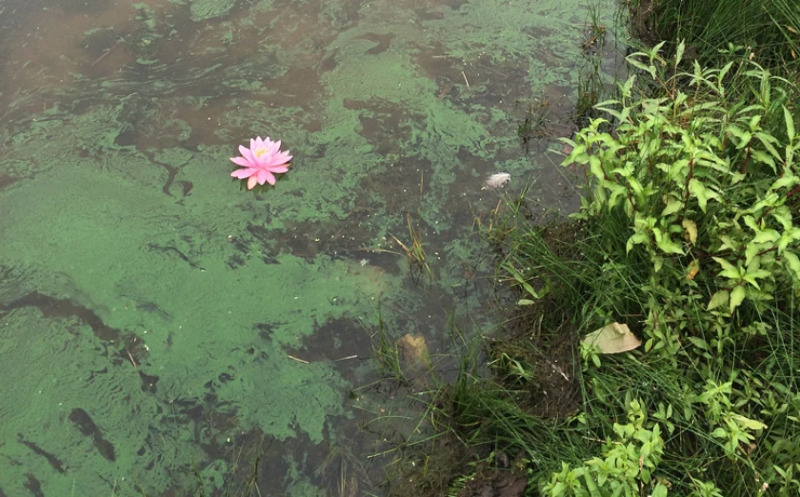
Student employees of the Lilly Center test for toxic algae on Lake Wawasee, the largest natural lake within Indiana. (Scott Perkins)
Living on Lake Wawasee, Cindy Peterson remembers it was once a sparkling clean lake.
“In the spring, you can see the bottom. It’s perfectly clear, very few weeds, beautiful,” she said. “And now we’re seeing more and more of the weeds, the algae blooms. ”
She worries about whether her grandchildren will be able to enjoy this well-loved northern Indiana lake as they get older. That’s why she offers her boat to researchers from the Lilly Center for Lakes and Streams at Grace College. The student employees head out on the lake weekly during the summer to test for harmful algae blooms and the conditions that produce them.
“It’s going to become a dead lake if we don’t maintain it. And that’s what they’re doing with all this testing,” Peterson said.

This partnership between local residents and environmental groups is unique — but it's becoming more necessary as toxic algae blooms increase with the combination of rising water temperatures and fertilizer run-off from fields. The only way to know if a bloom is toxic is to test and sometimes toxins can even be present without a visible algae bloom. Yet many states are not routinely testing their lakes before people or pets get in the water.
Due to funding and staff restrictions, the Indiana Department of Environmental Management can only test a small number of Indiana’s lakes. The Lilly Center takes over in Kosciusko County, which has the most lakes in the state — too many for IDEM to test. In the last two years, it also started sharing that information in a newsletter so visitors and residents can recreate safely.
Having people like Peterson who care about the lakes is a large part of what makes a program like this work. The other pieces are staff, labs and the money to pay for all of it, according to Jed Harvey, a research technician who runs the testing program.
“Science is tricky because you often have to follow the money, know where it’s coming from to see what gets done,” said Harvey. “But we are really blessed to have a lot of people around here who really care about the lakes.”
The Lilly Center for Lakes and Streams is entirely funded by donors. It gets its name from the pharmaceutical Lilly family, who have made significant donations through the Ruth Lilly Philanthropic Foundation. Much of the funding also comes from the well-off residents of Lake Wawasee where massive homes and expensive boats scatter across the lakefront.
For instance, donations from the residents enabled the Lilly Center to design a buoyfor Lake Wawasee that cost tens of thousands of dollars. It collects essential algae data in real-time. Most lakes don’t get nearly the same level of monitoring.
“We are aware that we will end up doing more on this lake than on other lakes,” said Harvey.

State algae testing
In the Midwest, state algae testing programs are often limited. The Indiana Department of Environmental Management tests only 18 lakes because of a lack of staff and funding.
“We have a very specific goal of protecting public health at swimming beaches and that's how we kind of keep this program on a smaller scale than just sampling all lakes in Indiana,” said Kristen Arnold, the chief of IDEM’s watershed assessment planning branch. “That would be impossible, so we have a very narrow focus of our project.”
When they do test, agencies look for toxins such as microcystin, cylindrospermopsin, saxitoxin, anatoxin-a and nodularin. Many other states only test when there has been a report of an algae bloom or someone has fallen ill. In Missouri, officials at the Department of Natural Resources said that’s because staff and funding is also an issue.
“Our water quality monitoring group, whenever something comes up they have to find somebody that's available to squeeze it in between projects,” said Lynn Milberg, director of the department’s Environmental Services Program.
Missouri DNR is also limited to accepting samples from lakes that are publicly managed. Milberg said the department knows alerting residents to harmful algae blooms is important, so it is working on an app that allows lake goers to easily report blooms that will then update an online map.
States like Iowa and Nebraska have routine monitoring of a larger number of lakes. Besides the public health benefit of gathering that information before people get in the water, there are other advantages to testing weekly, according to Daniel Kendall, an environmental specialist at Iowa Department of Natural Resources who manages the lake and beach monitoring programs.
“In my opinion, it keeps costs at a reasonable level, because we're able to do everything in-house,” Kendall said. “The cost is pretty reasonable when you're able to bulk sample and bulk process samples.”
State-wide testing also means that it is easier for lake-goers to find the results of the testing, which keeps people safer, according to Anne Schechinger, the Midwest director of the Environmental Working Group.
“If you have a state level program that tests a lot of water bodies, then, it's just the one website you go to check,” she said. “Or you know that this one lake is gonna be tested because it's on the schedule for the state agency.”
‘We can’t do everything’
In Missouri, about 200 volunteers work to help monitor the state's lakes. The Lakes of Missouri Volunteer Program, which is run by the University of Missouri and supported by various state agencies, recently celebrated its 30th year.
Seven years ago the group started testing for blue-green algae after watching Toledo, Ohio shut down its drinking water due to a harmful algae bloom in Lake Erie. Though the group’s testing isn’t seeing the high numbers of toxins as in some other states, program manager Tony Thorpe said testing is essential because it often finds toxins before visible blooms appear.
“We've seen cases where the lake is clear and pristine and beautiful, and yet we'll get hits on the toxins,” Thorpe said.

Yet relying on volunteers can also be limiting, especially when they are scarce in some places. Thorpe said he knows there are lakes that need more testing. Mozingo Lake in northwest Missouri, for example, has had algae blooms in the past and is also a drinking water reservoir for the city of Maryville.
“We've been trying to get somebody sampling on that lake for a few years,” Thorpe said.
Though it tests more routinely than the DNR, the volunteer program’s data is mostly for research purposes. Each lake is sampled about eight times during the summer and processed during the winter. Thorpe said the group would take on weekly testing, but it simply doesn’t have the funding or the staff to do so — and the problem isn’t going away.
“If we listen to the climate science, it seems to indicate that this is only gonna get worse and water is a scarce resource,” he said.
Given the limits of local testing, state governments and the federal government should be doing more, according to Schechinger.
“A lake that's publicly accessible, that should really be the state or the federal government's job to do the testing, not the people who live on the lake. It's a public resource,” she said.
Schechinger knows that state agencies want to do more testing, but it’s often up to the state legislature to direct more funding to the programs. Still, she said, relying too heavily on local testing could cause equity issues.
“People who live in an area where they're aware of the issue and have enough money to pay for testing are the ones who are going to get a lot more testing,” said Schechinger.
The Lilly Center’s Harvey said that focusing locally on Kosciusko County in Indiana has been working really well. But he acknowledged the impact of climate change on algae blooms could make it difficult for local groups to keep up.
“We can’t do everything for the whole state,” Harvey said, “but as blooms like this increase, it may be something where in some places the state needs to step up.”
Harvest Public Media’s Dana Cronin contributed to this story.
Eva Tesfaye covers agriculture, food systems and rural issues for KCUR and Harvest Public Media and is a Report For America corps member. Follow Eva on Twitter @EvaRTesfaye.
This story was produced in partnership with Harvest Public Media, a collaboration of public media newsrooms in the Midwest, and the Mississippi River Basin Ag & Water Desk.
Note: Blue green algae is currently being monitored by Indiana Department of Environmental Management. You can view test results for lakes in your area here.













